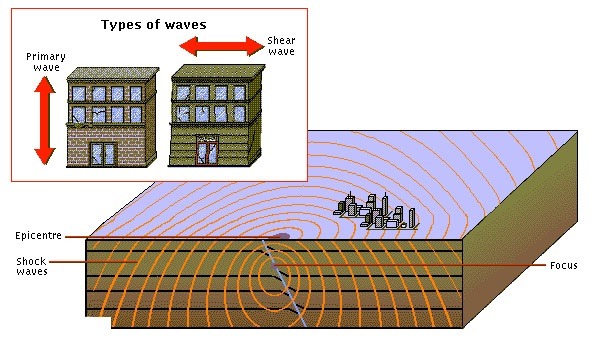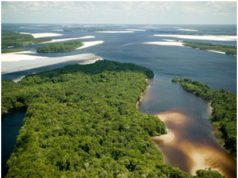Earthquake and Shock Waves
Earthquakes occur when a build-up of pressure or strain between sections of rocks within the earth’s crust is suddenly released, causing minor or severe vibrations on the surface of the land. The point at which layers of rock shift and reposition in relation to one another is called the focus; this is the effective centre of the earthquake. Directly above the focus, a second point called the epicenter marks the corresponding point of highest-intensity shock on the surface.
Shock waves propagate like ripples from the focus and epicenter, decreasing in intensity as they travel outwards. The main types of seismic waves are primary waves (P waves) and shear waves (S waves). P waves cause particles to vibrate in the same direction as the shock wave (left). P waves are the first to be recorded in an earthquake because they move faster than S waves (right), which cause vibrations perpendicular to the direction of travel
This short video excerpt is from a USGS/Bay Area Earthquake Alliance produced television program “Shock Waves: 100 Years After the 1906 Earthquake”. This specific segment describes some of the history behind our modern understanding of the earthquake process. The program received numerous industry awards and was nominated for a regional Emmy Award in the Bay area. It aired twice on KPIX CBS5 and its affiliate station around the time of the
This video gives an excellent description of the “elastic rebound theory” and explains how it applies to earthquakes on the
The Earthquake Commission found that the
Plate Tectonics is the overall model of how different parts of the Earth’s crust are moving relative to each other. And the crust of the Earth is broken up into major plates they slide past each other and they move on faults.
The
{loadposition earthquake_video}
Perhaps one of the most important results that came out of this study was the development of Harry Fielding Reid’s Theory of Elastic Rebound. He used the information collected from land surveys that allowed him to measure the changes in surface that had been caused by the earthquake. This was something that had been understood in rough form before the earthquake but he developed the first scientific theory about how forces accumulate along faults only to be released in earthquakes. We call this “The Elastic Rebound Theory” and it’s the foundation really of our modern understanding of the earthquake process. If you can think of the crust as a slab of rubber and you’re grabbing the rubber from the two sides and moving it past each other if the fault itself were Teflon the rubber would just move by and never be distorted. But, because the fault has friction then the rubber gets distorted and stresses are built up on that surface. So, that process is extremely slow. An inch a year, and suddenly at the time of the earthquake a very small piece of that highly fractioned surface is going to let go and as it does so it starts slipping. And in the space of a few seconds that slippage speeds up from an inch a year to 5000 miles an hour. And that process then tears down the fault at these high speeds until it comes to a stuck patch where it can hang there for several seconds. If it’s going to be a large earthquake it’s going to burst through, speed up again to 5000 miles an hour and go flying into the next knot in the piece of wood if you like. Hang there and then burst through again. In parts of California we just really have the San Andreas Fault. It’s the major feature. But, in places like the Bay area, the fault splays; it’s like the trunk of a tree. Comes into the Bay area, big branches come out; these are the major faults like the San Gregorio and the San Andreas and the Hayward and Rodgers Creek. The Calaveras, the Concord-Green Valley. And they accommodate most of the movement and then even little faults come off of them and they’re like smaller twigs. Each different sized fault produces different sized earthquakes and here in the Bay area we have many faults of different sizes spread out across the entire region. Each of those faults could produce a damaging earthquake, in fact taken together; we think a damaging earthquake is nearly twice as likely to happen as not over the next 30 years. More Earthquake information for the Bay area, California and worldwide can be found T http://earthquake.usgs.gov/. Science now gives us all a way to clearly see and understand the earthquake risk in our own lives. Kidsfreesouls Natural Calamities for Classroom Learning







